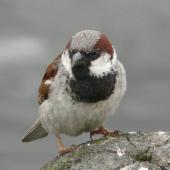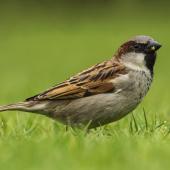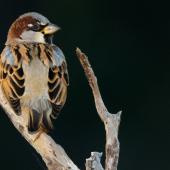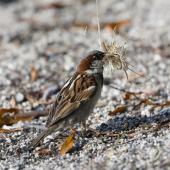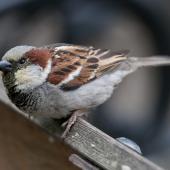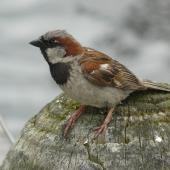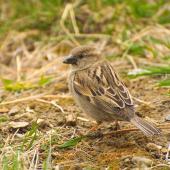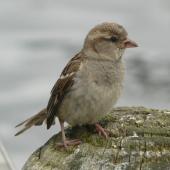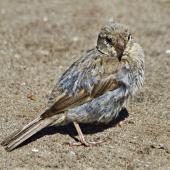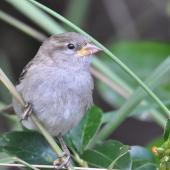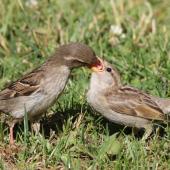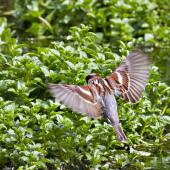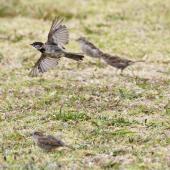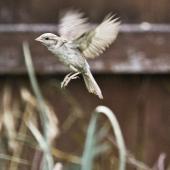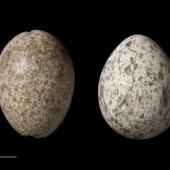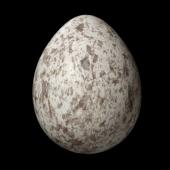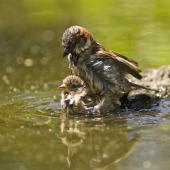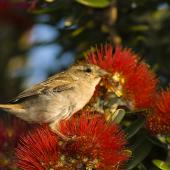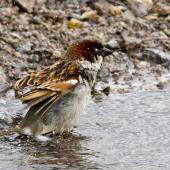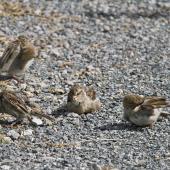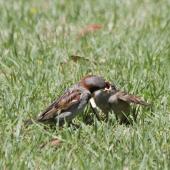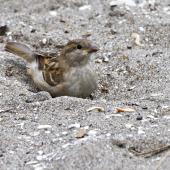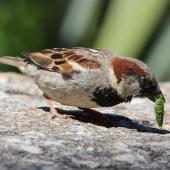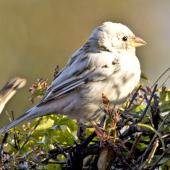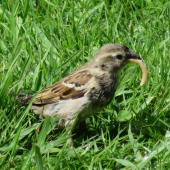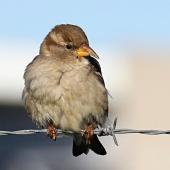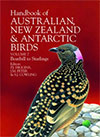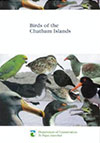House sparrow | Tiu
Passer domesticus (Linnaeus, 1758)
Order: Passeriformes
Family: Passeridae
New Zealand status: Introduced
Conservation status: Introduced and Naturalised
Other names: English sparrow
Geographical variation: New Zealand birds are assigned to the nominate subspecies domesticus.
One of the world’s most successful introduced species, the house sparrow is found from sub-Arctic to sub-Tropical regions everywhere, except Western Australia and some small islands. It lives mostly in close association with man. This ubiquity has led to many studies of it as a pest and of its physiology, energetics, behaviour, genetics and evolution. There is even a scientific journal devoted to work on the house sparrow and other Passer species.
House sparrows were introduced to New Zealand first in the mid 1860s. They soon became abundant and were said to be combating plagues of agricultural pests. By the 1880s, however, they were regarded as pests. Sparrows have made their own way to offshore islands, breeding on those with human habitation. They have evolved differences in morphology in response to local environments. The best source of information on sparrow biology is the monograph by Summers-Smith, although adjustment for the six-month difference in seasons is necessary.
Identification
Males are smart chestnut-brown, white-and-grey with a distinctive black “bib”; they are difficult to confuse with any other species. Females and young lack the bib and are greyer, with lighter brown dorsal plumage than the male. Their underparts are plain grey, but their backs and wings are variegated several shades of brown and white. The robust conical bill is black in breeding males, otherwise pale pinkish-brown. The eyes are dark brown and legs dull pink.
Voice: the familiar unmelodious chirp is the male’s song, and the same call is used by both sexes in roosts and other social gatherings. The alarm call is harsher.
Similar species: females and juveniles can be confused with dunnock, greenfinch or chaffinch. Dunnocks are smaller, with darker, more sombre plumage, and a slender dark bill. They usually stay close to cover, and are never in large flocks. Chaffinches differ in their distinctive double wing-bar and white outer tail. The young of greenfinches are greenish above their shorter tail. In comparison with finches, sparrow flight generally is more direct, almost laboured, and usually low.
Distribution and habitat
House sparrows are found everywhere except for high mountains and bush. They are most abundant in the north and in drier eastern areas and in association with arable farming and human habitation, including towns and cities. House sparrows are a common breeding species on the Chatham Islands, and have been recorded as vagrants on the Snares, Antipodes, Auckland and Campbell Islands.
Population
Sparrows vie with silvereyes in being the most abundant New Zealand bird, at least near human habitation. The population density in New Zealand is about 25 times that in comparable habitat in Britain, probably reflecting the scarcity of specialised predators of small birds in New Zealand. They are remarkably sedentary and even the large post-breeding flocks of late summer and early autumn venture no more than few kilometres from the breeding area. Survival rates are not known, but must be higher than at similar latitudes abroad, given the lower breeding productivity here. Mass mortality can occur when autumn roosts are hit by heavy rain, or in unseasonable snowstorms. In 2001, the New Zealand population suffered from an epidemic strain of Salmonella, but appears to have recovered. Populations in parts of Britain and north-western Europe declined significantly in the 1990s and have not recovered to previous numbers. The cause of this is unknown, but there is no evidence that New Zealand populations have similarly suffered.
Ecological and economic impacts
House sparrows take ripening grain, mainly wheat and barley, although the impact varies from field to field and within an individual field. The damage is economically significant, averaging around 5% of the potential yield of the crop. Other damage, such as to seedling peas, apples, soft fruit and fruit tree buds is less, but can be significant to individual farmers.
Breeding
Breeding is semi-colonial, but nests are normally spaced over a metre apart, mainly in holes in buildings. The chirping male defends a small territory around the nest site. Eggs are laid from late September to early February. Incubation overnight is by the female; the male has no brood patch and plays a minor role by day only. Sparrows are largely monogamous, but studies abroad show a low incidence of polygamy and brood parasitism, with up to 10% of nestlings not from the nesting pair. The male feeds the nestlings more when the young are small, but the roles reverse for older nestlings. Another clutch can be initiated within five days of a brood fledging, but the interval averages 10 days. The average clutch is 3.8 and there are up to four clutches a year, but mortality of eggs and nestlings is high. Given this, breeding productivity in New Zealand is remarkably low, averaging between 1.6 and 1.9 fledglings per nest, lower than comparable figures for Britain, but it does vary greatly from place to place and year to year.
Behaviour and ecology
The sparrow is a flocking species, and is not often seen alone. Roosting is communal: sometimes several hundreds in dense shrubs or trees. The secret of the sparrow’s success seems to lie in its association with man; both the nest sites and much of the food depend upon human endeavour and it is exceptional to find sparrows living away from habitation.
Food
The diet in New Zealand is similar to that in temperate climes abroad. Adults eat mainly grain, including cereal and maize crops, but also the buds, flowers, nectar, fruit and seeds of a wide range of other introduced plants (especially amaranth, birch, knotweed, meadow grass, fat-hen, chickweed and mouse-ear). Around towns and cities, much of the diet is human food scraps provided inadvertently or deliberately, especially bread. Invertebrates are a minor element of the adult diet, mainly beetles, grasshoppers, bugs, aphids, scale insects, caterpillars, craneflies, muscid flies and spiders. Occasionally, sparrows hawk for flying insects, e.g. cicadas. Small nestlings are fed predominantly on invertebrates. As the nestlings become older, their parents bring more vegetable matter, including the softer items of the adult diet, but still feed many invertebrates.
Weblinks
References
Alley, M.R.; Connolly, J.H.; Fenwick, S.G.; Mackereth, G.F.; Leyland, M.J.; Rogers, L.E.; Haycock, M.; Nicol, C.; Reed, C.E.M. 2002. An epidemic of salmonellosis caused by Salmonella typhimurium DT160 in wild birds and humans in New Zealand. New Zealand Veterinary Journal 50: 170-178.
Anon 2002. Causes of death in wild birds. Veterinary Times 9th September.
Baker, A.J. 1980 Morphometric differentiation in New Zealand populations of the house sparrow (Passer domesticus). Evolution 34: 638-653.
Child, P. 1975. Unusual nest sites of house sparrow and paradise duck. Notornis 22: 121.
Dawson, D.G. 1964. The eggs of the house sparrow. Notornis 11:187-189.
Dawson, D.G. 1966. Breeding in the house sparrow (Passer domesticus L.). University of Canterbury, BSc(Hons) Project, Zoology, 47pp.
Dawson, D.G. 1967. Roosting sparrows (Passer domesticus) killed by rainstorm, Hawke’s Bay, New Zealand. Notornis 14: 208-210.
Dawson, D.G. 1970. Estimation of grain loss due to sparrows (Passer domesticus) in New Zealand. New Zealand Journal of Agricultural Research 13: 681-688.
Dawson, D.G. 1972. House sparrow, Passer domesticus (L.), breeding in New Zealand. Pp 129-131 in Kendeigh, S.C.; Pinowski, J. (eds) Productivity, population dynamics and systematics of granivorous birds. PWN-Polish Scientific Publishers, Warszawa.
Dawson, D.G.; Bull, P.C. 1970. A questionnaire survey of bird damage to fruit. New Zealand Journal of Agricultural Research 13: 362-71.
Heather, B.D.; Robertson, H.A. 1996. The field guide to the birds of New Zealand. Viking, Auckland.
Kendra, P.E., Roth, R.R.; Tallamy, D.W. 1988. Conspecific brood parasitism in the house sparrow. Wilson Bulletin 100: 80-90.
MacLeod, C.J.; Newson, S.E.; Blackwell, G.; Duncan, R.P. 2009. Enhanced niche opportunities: can they explain the success of New Zealand’s introduced species? Diversity and Distributions 15: 41-49.
MacLeod, C.J.; Drew, K.W.; Coleman, M. 2011. Radio-tracking small farmland passerines: trade-offs in study design. Notornis 58: 113-123.
MacMillan, B.W.H. 1981. Food of house sparrows and greenfinches in a mixed farming district, Hawkes Bay, New Zealand. New Zealand Journal of Zoology 8: 93-104.
MacMillan, B.W.H.; Pollock, B.J. 1985. Food of nestling house sparrows (Passer domesticus) in mixed farmland of Hawke’s Bay, New Zealand. New Zealand Journal of Zoology 12: 307-317.
Niethammer, G. 1970. Clutch sizes of introduced European Passeriformes in New Zealand. Notornis 17: 214-22.
Spurr, E.B. 2012. New Zealand Garden Bird Survey – analysis of the first four years. New Zealand Journal of Ecology 36: 287-299.
Stidolph, R.H.D. 1974. The adaptable house sparrow. Notornis 21: 88.
Summers-Smith, D. 1963. The house sparrow. Collins, New Naturalist, London.
Summers-Smith, J.D. 1988. The sparrows. A study of the genus Passer. Poyser, Calton.
Summers-Smith, J.D. 2005. Changes in the house sparrow population in Britain. International Studies on sparrows 30: 23-37.
van Heezik, Y.; Smyth, A.; Hathieu, R. 2008. Diversity of native and exotic birds across an urban gradient in a New Zealand city. Landscape and Urban Planning 87: 223-232.
Waddington, D.C.; Cockrem, J.F. 1987. Homing ability of the house sparrow. Notornis 34: 57-58.
Williamson, W.A. 1950. Nest of house sparrow. New Zealand Bird Notes 3: 198.
Recommended citation
Dawson, D.G. 2013 [updated 2022]. House sparrow | tiu. In Miskelly, C.M. (ed.) New Zealand Birds Online. www.nzbirdsonline.org.nz
House sparrow | Tiu
- Breeding season
-
- Jul
- Aug
- Sep
- Oct
- Nov
- Dec
- Jan
- Feb
- Mar
- Apr
- May
- Jun
- Egg laying dates
-
- Jul
- Aug
- Sep
- Oct
- Nov
- Dec
- Jan
- Feb
- Mar
- Apr
- May
- Jun
House sparrow
- Social structure
- monogamous
- Breeding season
-
- Jul
- Aug
- Sep
- Oct
- Nov
- Dec
- Jan
- Feb
- Mar
- Apr
- May
- Jun
- Nest type
- enclosed dome
- Nest description
- Nest usually in the eaves of a building or other crevice. Especially in warmer regions can be in dense trees, shrubs and climbers. They are bulky and untidy, domed with a side entrance hole. Made mainly of grass, straw or similar fibres and lined with feathers. A great variety of man-made materials can be incorporated.
- Maximum number of successful broods
- 4
- Clutch size (mean)
- 3.8
- Clutch size (min)
- 2
- Clutch size (max)
- 5
- Mean egg dimensions (length)
- 21.90 mm
- Mean egg dimensions (width)
- 15.30 mm
- Egg colour
- White with greatly varying density and size of grey or brown spotting usually more dense at the broad end and less in the last egg laid.
- Egg laying dates
-
- Jul
- Aug
- Sep
- Oct
- Nov
- Dec
- Jan
- Feb
- Mar
- Apr
- May
- Jun
- Interval between eggs in a clutch
- 1 day
- Incubation behaviour
- shared
- Incubation length (mean)
- 12 days
- Incubation length (min)
- 10days
- Incubation length (max)
- 15days
- Nestling type
- altricial
- Nestling period (mean)
- 15 days
- Nestling period (min)
- 11 days
- Nestling period (max)
- 20days
- Age at fledging (mean)
- 15 days
- Age at fledging (min)
- 11days
- Age at fledging (max)
- 20days
- Age at independence (mean)
- 7 days
- Age at independence (min)
- 5 days
- Age at independence (max)
- 14 days
- Age at first breeding (typical)
- 1 year
- Maximum longevity
- 15 years
- Maximum dispersal
- 300 km




